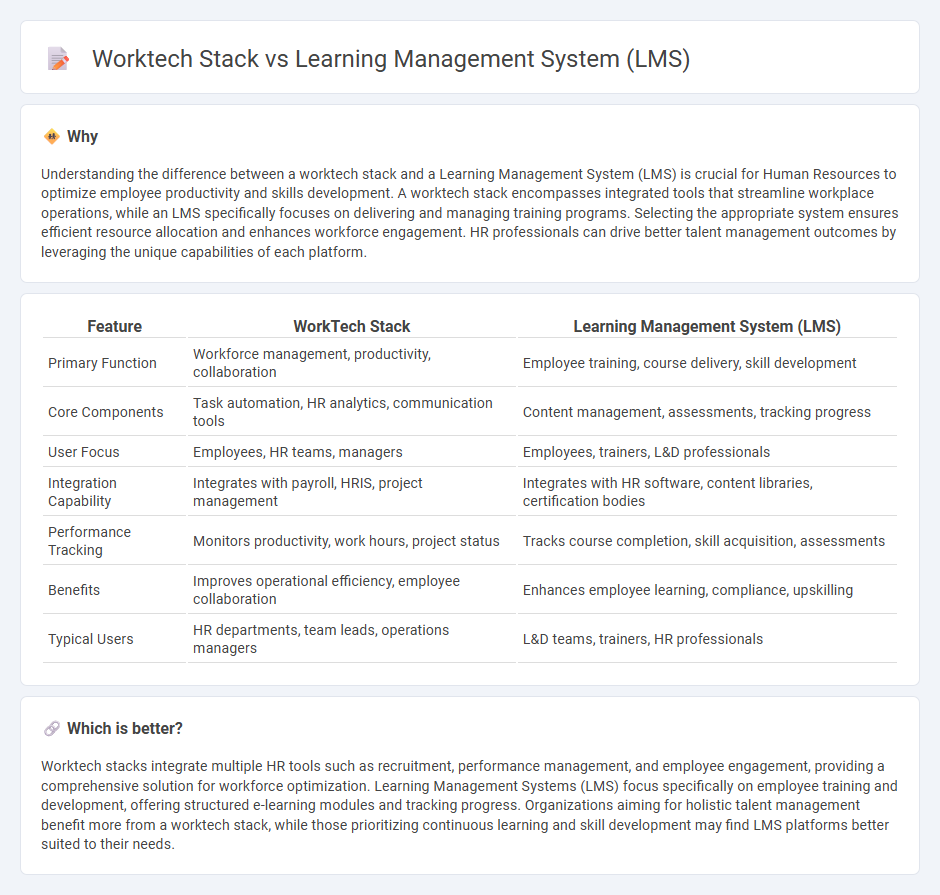
Worktech stacks integrate various tools to enhance HR processes like recruitment, payroll, and employee engagement, focusing on operational efficiency and data analytics. Learning Management Systems (LMS) prioritize employee training and development by providing structured content delivery, progress tracking, and skill assessment features. Explore the differences between worktech stacks and LMS to optimize your organization's human capital strategy.
Why it is important
Understanding the difference between a worktech stack and a Learning Management System (LMS) is crucial for Human Resources to optimize employee productivity and skills development. A worktech stack encompasses integrated tools that streamline workplace operations, while an LMS specifically focuses on delivering and managing training programs. Selecting the appropriate system ensures efficient resource allocation and enhances workforce engagement. HR professionals can drive better talent management outcomes by leveraging the unique capabilities of each platform.
Comparison Table
| Feature | WorkTech Stack | Learning Management System (LMS) |
|---|---|---|
| Primary Function | Workforce management, productivity, collaboration | Employee training, course delivery, skill development |
| Core Components | Task automation, HR analytics, communication tools | Content management, assessments, tracking progress |
| User Focus | Employees, HR teams, managers | Employees, trainers, L&D professionals |
| Integration Capability | Integrates with payroll, HRIS, project management | Integrates with HR software, content libraries, certification bodies |
| Performance Tracking | Monitors productivity, work hours, project status | Tracks course completion, skill acquisition, assessments |
| Benefits | Improves operational efficiency, employee collaboration | Enhances employee learning, compliance, upskilling |
| Typical Users | HR departments, team leads, operations managers | L&D teams, trainers, HR professionals |
Which is better?
Worktech stacks integrate multiple HR tools such as recruitment, performance management, and employee engagement, providing a comprehensive solution for workforce optimization. Learning Management Systems (LMS) focus specifically on employee training and development, offering structured e-learning modules and tracking progress. Organizations aiming for holistic talent management benefit more from a worktech stack, while those prioritizing continuous learning and skill development may find LMS platforms better suited to their needs.
Connection
The worktech stack integrates with Learning Management Systems (LMS) to streamline employee training and development within Human Resources, enhancing talent management efficiency. By connecting LMS platforms with performance data and communication tools in the worktech stack, organizations enable personalized learning pathways aligned with individual and organizational goals. This integration improves skill tracking, compliance adherence, and overall workforce productivity through seamless data synchronization and real-time analytics.
Key Terms
Course Delivery
A Learning Management System (LMS) specializes in course delivery by offering structured content management, assessment tools, and learner tracking to enhance training effectiveness. In contrast, a worktech stack integrates LMS capabilities with broader workplace technologies such as collaboration, performance management, and workflow automation. Explore how choosing the right platform can optimize your organization's learning and operational efficiency.
Integration
A seamless integration between Learning Management Systems (LMS) and worktech stack enhances employee training efficiency and knowledge retention by synchronizing learning data with daily workflow tools. Integrating platforms like SAP SuccessFactors LMS or Cornerstone OnDemand with worktech applications such as Slack, Microsoft Teams, or Asana ensures real-time access to training content and performance analytics, driving organizational learning agility. Explore how strategic LMS-worktech integration can transform your workforce learning experience.
Employee Analytics
Employee analytics in Learning Management Systems (LMS) provides detailed insights into training engagement and skill development, helping organizations tailor learning paths effectively. In contrast, worktech stacks integrate employee analytics to monitor productivity, collaboration patterns, and overall workforce performance for strategic decision-making. Explore how combining LMS and worktech analytics can optimize employee growth and organizational efficiency.
Source and External Links
Learning management system - An LMS is software for managing, delivering, and tracking educational courses and training programs, widely adopted in education and adapted for remote learning growth since the 1990s.
What is a Learning Management System (LMS)? - An LMS is a web-based platform enabling course creation, delivery, student tracking, and assessments, used by businesses and schools to improve education efficiency and standardization.
What is an LMS (Learning Management System)? - LMS platforms create, deliver, and manage learning content with features like quizzes and analytics, reducing training costs and improving compliance and progress tracking for organizations.
 dowidth.com
dowidth.com